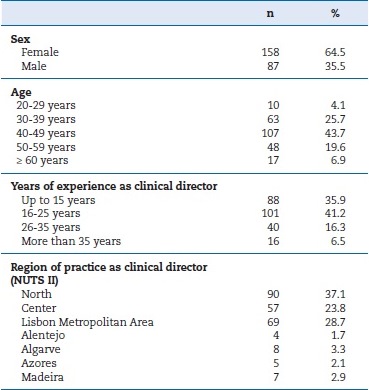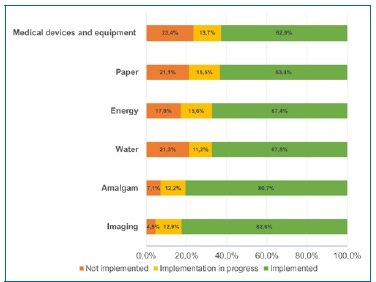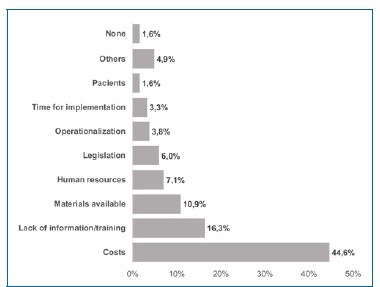Introduction
Recently, the world has been facing an increasing awareness of environmental problems.1-3 Thus, the development of responsible environmental practices has become increasingly urgent for dental companies.4,5 Although dental clinics alone produce a small amount of waste, globally, they can significantly affect the environment.
The dental practice consumes many resources with an environmental impact, such as the energy and water used by the equipment, the materials used, the X-ray radiation, and the waste from products involving metals like mercury and silver.6,7Therefore, dentists have professional and social responsibilities to make their daily clinical routine more sustainable by adopting ecological practices.8-10Dentistry must incorporate sustainable development objectives in the clinical practice and contribute to the transition to an eco-friendly economy.11
The “Green Dentistry” ideology is based on the four Rs of sustainability - Reduce, Reuse, Recycle and Rethink - as follows:
• Reduce the number of resources used, directly reducing the waste generated.
• Reuse devices and equipment by adopting reusable alternatives to materials such as cups, vacuum cleaners, and other equipment used in daily clinical practice, thus significantly reducing the amount of disposable plastics that are not biodegradable and pollute the environment.12
• Recycle materials such as glass, paper, plastic, and aluminum, promoting their selection and separation to allow subsequent recycling.12,13
• Rethink what changes can be made by planning all operational strategies of a dental clinic based on environmental sustainability and leading to positive and evident effects in reducing energy and water costs.14
The 2030 Agenda for Sustainable Development, adopted by the United Nations in 2015, outlines 17 Sustainable Development Goals (SDGs) with 169 targets and is organized into five framing principles, called the 5Ps - People, Planet, Prosperity, Peace, and Partnerships. Its objectives are based on an integrative and interconnected vision of the various dimensions of sustainable development (economic, social, and environmental).15 SDG no. 12 aims to achieve, by 2030, the sustainable management and efficient use of natural resources, with a significant reduction of resources released into the air, water, and soil, thereby minimizing negative impacts on human health and the environment. Also, it intends to substantially reduce waste generation through prevention, reduction, recycling, and reuse.15 Dental companies should integrate this SDG in their decisions and planning.
Considering this ecological responsibility, the Portuguese Dental Association (OMD, Ordem dos Médicos Dentistas) approved, in April 2021, the manual “Good Practices for Sustainable Events,”16 a guide aimed to contribute to the 2030 Agenda by suggesting the implementation of sustainability policies in dental companies. It raises awareness among the teams responsible for planning and organizing events, promoting more environmentally friendly strategies and procedures.
Environmental sustainability in dental clinical practice is a current yet marginally studied topic. The present study aimed to contribute to understanding this thematic in the Portuguese population, having the following objectives: 1) To describe the implementation of environmental sustainability practices in Portuguese dental clinics; 2) To know the importance and interest given by clinical directors to environmental sustainability practices, as well as the barriers felted in their applicability.
Material and methods
This cross-sectional observational study’s target population consisted of stomatologists and dentists who were clinical directors in Portugal. All clinical directors who voluntarily agreed to participate were included in the study. The study was previously approved by the Ethics Committee of the Faculty of Dental Medicine of the University of Lisbon.
The study collected data through an online questionnaire adapted from a previous one applied to a Jordan population in 2013.17 The adaptation was reviewed by three experts (oral health professionals and researchers with experience in questionnaire construction) that verified the relevance and clearness of the questions. After this evaluation, the questionnaire was submitted to a pre-test on six oral health professionals.
The questionnaire collected information about the respondents’ sociodemographic and professional characteristics, the implementation of environmental sustainability practices in their dental clinics within six management categories -medical devices and equipment, amalgam, imaging, paper, energy, and water, their opinion on the importance, interest, and benefit of sustainability practices in dental clinics, and the barriers felt in their implementation. The questionnaire was shared in several groups of dental clinicians on social networks and in some oral health magazines published in digital format. It was also disclosed by the Portuguese Society of Stomatology and Dental Medicine (SPEMD, Sociedade Portuguesa de Estomatologia e Medicina Dentária) by email to all its members. The link to the questionnaire was available between February and April 2021.
Statistical analysis was performed with SPSS (Statistical Package for the Social Sciences) version 27.0 and included the descriptive statistics, with the calculi of the absolute and relative frequencies of all the variables. To allow the comparison between the various categories of sustainability practices, their implementation’s percentage mean was calculated by summing all values in percentage and dividing them by the number of items in each category.
Results
The sample consisted of 245 participants. Table 1 shows the sociodemographic and professional characterization of the sample. Most participants were female (64.5%) and belonged to the 40-49 years age group (43.7%). The most represented regions in the sample were the North of Portugal (37.1%) and the Lisbon Metropolitan Area (28.7%).
In general, there was a high percentage of environmental sustainability practices implementation, with the imaging category having the highest mean percentage of implementation (82.6%) and the medical devices and equipment management having the lowest (62.9%) (Figure 1). Table 2 shows the percentage of environmental sustainability practices implemented in the medical devices and equipment, dental amalgam, and imaging categories. In the medical devices and equipment management category, very high levels of implementation were reported in the use of reusable personal protective equipment (91.3%) and intraoral digital scanning techniques (93.9%). Practices frequently reported as “not implemented” included the use of reusable cups (62.5%) and reusable saliva aspirators (60.5%). All dental amalgam and imaging practices had high levels of implementation (above 70%).
Table 3 presents the results of the paper, energy, and water management categories. Digital technologies were used to manage patient information in most of the respondents’ clinics (84.9%) but not for communication with suppliers and laboratories (36.6% not implemented). The use of recyclable paper showed the lowest percentage of implementation (30.7%). Regarding energy management, automatic thermostats in air conditioning systems were little implemented (39.4). As for water management, only water taps with a sensor/timer were little implemented (42.8%).

Figure 2 Importance given to implementing environmental sustainability practices at the dental clinic.
Table 2 Percentage of environmental sustainability practices implementation in the categories of medical devices and equipment, dental amalgam, and imaging.
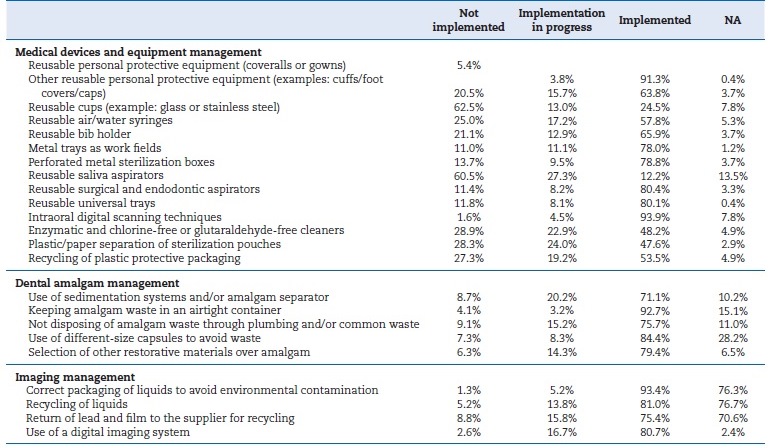
NA - not applicable
Almost all participants (95.5%) considered the implementation of environmental sustainability practices in the dental clinic as important (56.7%) or very important (38.8%) (Figure 2).
Most participants (87.3%) showed interest in receiving information about environmental sustainability practices for dental clinics, and almost all (95.1%) considered that these are beneficial for the environment but are also long-term economically important for the clinic. Nevertheless, the main barriers to the implementation of environmental sustainability practices mentioned were the costs (44.6%) and the lack of information/ training (16.3%) (Figure 3).
Table 3 Percentage of environmental sustainability practices implementation in the categories of paper, energy, and water.
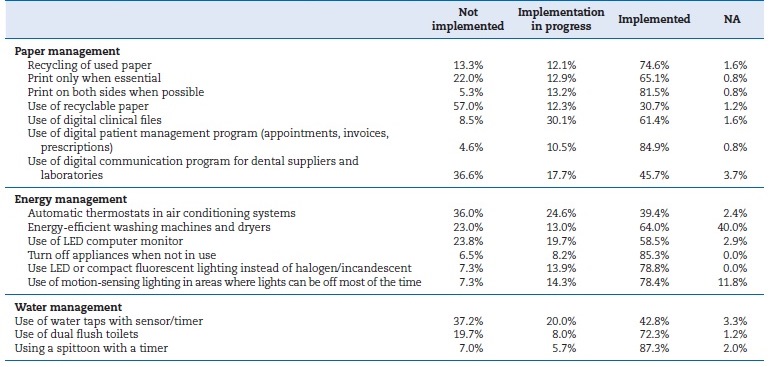
NA - not applicable
Discussion
This study aimed to increase the knowledge about sustainable practices implementation in Portuguese dental clinics and check if they converge with the goals outlined by the International Dental Federation (FDI) in its “Vision 2030: Delivering Optimal Oral Health for All” report. By 2030, in collaboration with other healthcare professionals, oral healthcare professionals should provide sustainable, needs-based, patient-centered healthcare.18
Sustainable dentistry is an alternative approach to conventional dentistry that meets the needs and satisfaction of the patients19 of current generations without compromising future generations by reducing environmental risks. This transition will reduce the dental profession’s environmental impact through the ecological attitudes of a team motivated to change, the correct handling of toxic substances, the change to reusable and/or biodegradable materials, and the use of high-technology products and devices.20,21
According to the OMD’s deontological code, clinical directors are responsible for coordinating and supervising the functioning of the dental clinic.22 Thus, these professionals play a very important role in the transition to a more sustainable practice, which was why they were selected as the target population of the present study. The sample of the present study had an expected distribution, with more female participants exercising their activity in large cities of Portugal, which agrees with the numbers indicated by the OMD.23 Also, it is very diverse, with representation from all Portuguese regions and various age groups. Although no information was found on the number of clinic directors in Portugal, data from the Bank of Portugal indicated that there were around 6300 dental companies as of 2020.24 So, the sample would correspond to 4% of the population, which is quite relevant. Despite these characteristics, being a non-probabilistic sample, results’ extrapolation to the target population must be cautious.
Regarding sustainable practices in the category of medical devices and equipment, reusable personal protective equipment (PPE) was one of the most implemented. Health professionals are encouraged to optimize universal precautions against infection, adopting practices that ensure their and their patients’ protection, considering factors such as the pathogen’s virulence, operator comfort, ergonomics, reusability, and associated cost.25 Since the study was carried out during a pandemic in which, initially, PPE was lacking and had elevated costs, reusable PPE, besides being the best economic and environmental option, may also have been the most available option in the medium/long term.
On the other hand, reusable cups and reusable saliva aspirators had the highest non-implementation percentages, respectively, 62.5% and 60.5% of the participants. Similar results on reusable cup non-adherence were shown in a previous study (65.6%),26 and even higher non-adherence was found in a study in Jordan (86.7%).17 These attitudes contribute to increasing plastic waste produced by the clinics. Conversely, another study in Bhopal, India, found that reusable saliva aspirators were very popular (83.2%).27 The pollution generated by clinical dental practice is caused mainly by disposable items. However, the low percentage of use of some reusable products may be related to some insecurity in the control of cross-infection of sustainable materials due to the impossibility of guaranteeing good disinfection and sterilization of the type of material available.
The most implemented practice in this category was intraoral scanning techniques, with a high percentage of implementation (93.9%), contrary to other studies from the last decade, which mention that its low implementation was due to the high cost of intraoral scanning equipment.17,28 This change may result from the current digital revolution in the prosthodontics field that led to strong competition in the digital equipment market, making it more available for dental clinics29 and laboratories.
Regarding cleaning products, less than half of the participants (48.2%) reported using enzymatic and chlorine-free or glutaraldehyde-free ones. The more traditionally used cleaning products, with chlorine and ammonium compounds, have a corrosive effect and can produce highly toxic secondary compounds when reacting with other chemicals. For example, using chlorine-based disinfectants to disinfect pipes and plumbing may cause the release of mercury vapors. On the other hand, disinfectants whose composition includes glutaraldehyde, also probably widely used, can promote bacterial resistance. Since the toxic substances resulting from the use of these products can directly or indirectly reach the basic sanitation system and, later, the environment, there is a recommendation to gradually replace them with enzymatic products.20
Another practice in this category with low implementation was the paper/plastic separation of the sterilization pouches, performed in 47.6% of the dental clinics. The oral health team can easily adopt this practice, and it would enable the recycling of plastic waste.20
The present study found a high percentage of implementation of all environmental sustainability practices related to the dental amalgam management category, similar to other studies.27,30On the contrary, in a study carried out in Jordan,17 the only practice implemented was using capsules of different sizes to use alternative restorative materials, such as resins. In turn, Thailand dentists have shown negative attitudes toward alternative materials and, specifically, a percentage of use of amalgam substantially higher than in the present study.31 The present study’s sustainable practices related to dental amalgam meet the current Portuguese legislation regulating the correct amalgam waste management.
They also comply with FDI’s requirements (2019) regarding the reduction of dental amalgam use and the recommendation to increase the teaching of other alternative restorative materials.32
The sustainability practices in the imaging category had the highest implementation percentages, contrary to other studies.17,27 The most sustainable practice is using a digital X-ray system, which does not require chemicals, plastics, paper, or lead films. Additionally, digital imaging systems have the advantages of exposing the patient to a lower dose of ionizing radiation, providing high-quality and high-precision images, and enabling easy storage and transmission to any part of the world.20
Regarding paper management, most participants generally indicated that they performed simple, sustainable practices, as in other studies.17,27 Reducing the use of paper and replacing it with digital systems has not only made a major contribution to reducing deforestation but also to reducing the greenhouse effect and, consequently, global warming.33
However, less than half (45.7%) of the participants implemented digital communication for dental laboratories. The existent digital guides can contain information about the patient and the intended restoration/prosthesis.34 Additionally, they tend to be filled out by the clinician in a systematic and organized structure, making the information clearer for the reader and eliminating the problem of interpreting the clinician’s handwriting.
Sustainable practices in energy management had a very satisfactory degree of implementation in the study, except regarding the use of automatic thermostats in air conditioning systems - these results are similar to other studies.17,30These results may derive from some dental offices not having an air conditioning system due to high purchase and maintenance costs.
Regarding water management, this study shows a high percentage of sustainable practices implementation, except regarding water taps with a sensor/timer, and these values are comparable with other studies.17,27 Again, these results may derive from the costs inherent to the acquisition of these systems compared to conventional taps.
In general, the participants demonstrated good environmental conscience since they had already implemented many environmental sustainability practices in the dental clinic. The implementation of these practices in the various categories may be considered very satisfactory because the percentages of “not implemented” practices were quite low, e.g., 4.5% in imaging and 7.1% in dental amalgam management. Nevertheless, the high implementation percentage of sustainable amalgam practices may be related to Portuguese legal requirements for dental clinics.
The most reported barrier felt during the implementation of environmental sustainability practices was costs, followed by the lack of information/training. Similar studies also indicated costs as impeditive to the implementation of sustainability practices.17,27 However, it is important to notice that, in the medium term, more-sustainable practices will promote economic gains besides environmental ones.20 Nonetheless, many clinicians may not be able to support the initial investment required, so national funding programs to support the implementation of sustainable practices, similar to those existing for domestic use, would be interesting. The regulatory authorities could also consider an energy and environmental certification for dental offices that would entitle them to a reduction in taxes as an incentive to implement these practices. In turn, the dental industry should invest in developing sustainable oral health products35 and biodegradable oral biomaterials.
Despite having a non-probabilistic sample, the present study intended to understand current sustainable dentistry practices in Portugal because, to date, no similar studies have been published. More studies on the subject are needed to provide more evidence-based information that will facilitate the change for a greener and more environmentally friendly dental medicine.
Conclusions
The results demonstrated that clinical directors had good environmental awareness, with a satisfactory implementation of environmental sustainability practices in dental clinics. Their best implementation percentages were in imaging and the worst in medical devices and equipment. The participants reported costs and lack of information/training as the main barriers to further practices.














